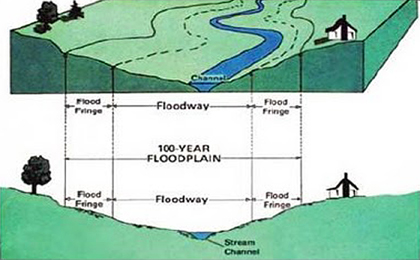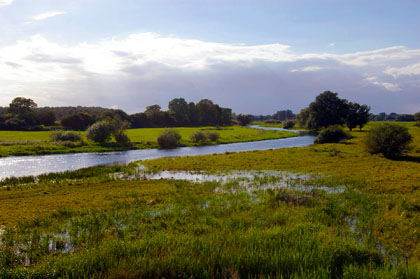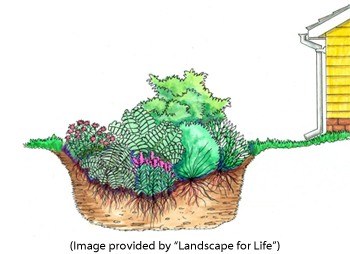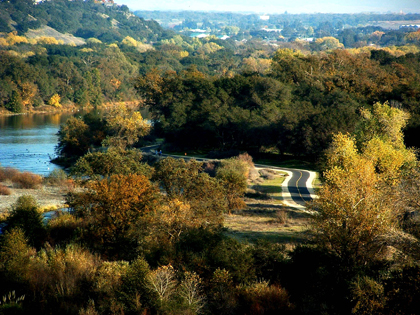
Natural benefits of the floodplain
Floodplains and floodways hold large quantities of water after rain or snow events. In their natural state these native areas, with their deep rooted native plants, filter out pollutants and chemicals from the water further protecting our rivers’ water quality. Natural site features such as wetlands with native plants and hydric soils have long disappeared and they no longer can function as they should. Landowners are encouraged to plant native plants on their property. These plants will assist with absorption and filtration of water. They will help to hold soils to keep erosion and siltation from occurring in the waterway. Landowners are also encouraged to remove any obstructions which might restrict water conveyance during high water events.?

We all Live in a Watershed?
Everyone lives in a watershed regardless of whether their property is in a designated floodplain or not. A watershed is simply a land area that collects and feeds water runoff into a channel or drain. This water can come in the form of rain, snow, irrigation, etc. There are a number of manmade features which feed water runoff from the watershed into our rivers, lakes or streams. These include drainage swales, paved surfaces such as streets or driveways, storm sewers, etc.
Located in these watersheds are areas designated as floodway and floodplain. The floodway is the channel or area that conveys water, i.e. a river, stream or creek. The floodplain is that area that is below the base flood elevation and is susceptible to flooding. By their very definition, these areas require special care and attention. They serve a very important function in protecting and enhancing the watershed.

How Rainfall Effects Water Quality?
Because we all live in a watershed we all contribute to the water runoff. We need to be aware of our impact. We must not wash pollutants or chemicals into the storm sewers. These storm sewers feed into our open waterways. We should strive to keep water that falls on our property on our property. This can be done through directing water runoff from our roofs, sump pumps and driveways into rain barrels, rain gardens, open vegetated swales or other features where that water can be used in a constructive way or absorbed by plants. We should consider planting plants on our property that are native to our area. They require less watering and absorb more water than many non-native plants. We need to look for ways to reduce impermeable surfaces so that water can reach the soil rather than run off causing flooding.
?
Untreated water pollutes creeks and rivers. Before the Sacramento area was developed, most rainfall fell onto natural areas and the water soaked into the ground. Over the last century, we've changed the landscape dramatically by adding roads and buildings and drainage pipes. Storm water that once soaked into the ground now flows quickly into street gutters and drains. It is then carried in pipes to our creeks and rivers without treatment. Everyday activities also add water: activities such as car washing, lawn watering, and cleaning buildings and streets. Along the way, the fast-moving urban runoff picks up pollutants such as pesticides, fertilizers, eroded soil, and oil and grease from cars. These pollutants make their way into our creeks and rivers where they pollute the water and harm the ecosystem of both plants and animals. Eventually, this affects all of us, since we eat the fish and use the rivers for recreation. Some of us in the Sacramento area also drink treated river water.

The Role Our Parks Play
Natural and beneficial functions are reflected throughout the County of Sacramento primarily through Regional Parks. For example, the Dry Creek Parkway provides boundless recreational opportunities for its surrounding communities including a golf course, horse trails, picnic facilities, fishing, soccer fields, and hiking trails. You can find the 6-mile Dry Creek Corridor in the northern part of Sacramento County, just below the Sacramento/Placer County line. Preserving the Dry Creek Parkway also meets the County's policy of protecting floodplains from development and adding to open spaces.
More Information
